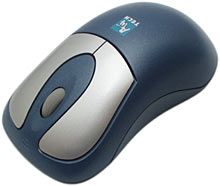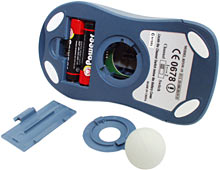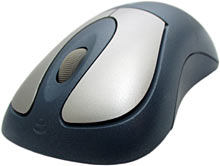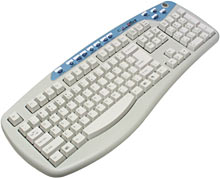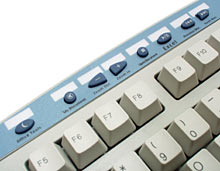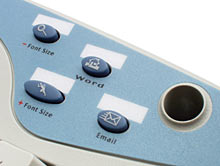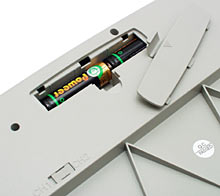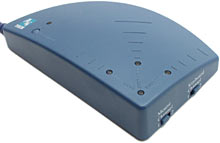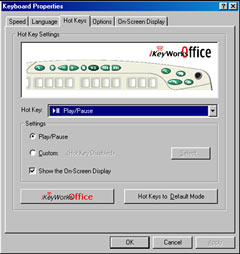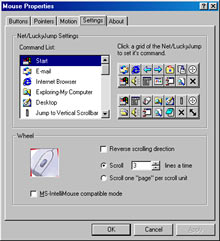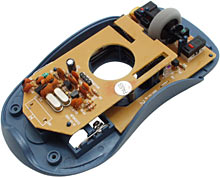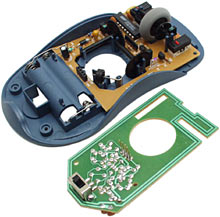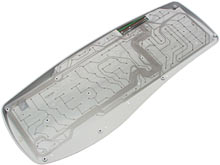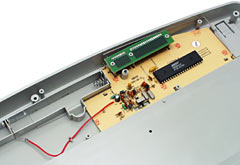
A4 Tech RFKB-5 cordless mouse and keyboard set
Review date: 26 January 2002. Last modified 03-Dec-2011.
Cordless mouse and keyboard sets definitely have their attractions. If you want to set up a lounge room PC, or control business presentations from a distance, or even control a computer that's locked up in a cupboard, a radio frequency (RF) wireless input device set is a much more elegant solution than running extension cords and drilling holes in things.
But the cordless kits also have their limitations.
For a start, some cordless input devices use remote-control-style infra-red (IR) light, not RF. This Book PC's keyboard and the wireless keyboard reviewed here, for instance. IR devices only work if they've got line-of-sight to their receiver, or at least a pretty good light-bounce path. They're generally not as bad as you might think, but they're still no good for a computer in a cupboard, unless the receiver's dangling outside.
RF solutions also don't necessarily have enough range to suit your application. Radio range varies depending on where you put the receiver unit - away from your computer and other RF noise sources, by preference - but a range of only a couple of metres is common enough, particularly for the weedy, small-antenna transmitters inside the mouses.
And then there's mouse sample rate - how often the pointer location is updated, which determines how smoothly it moves. if you're used to the 100Hz-plus sample rate of all USB mouses on Windows systems, the much slower update rate of an awful lot of wireless mouses, even those from big names (like the ones reviewed here, for instance...), will disappoint you.
And then there's price.
Logitech's Cordless Desktop series is a popular option, but you're looking at more than $AU170, delivered, for the basic Cordless Desktop at the moment. The Cordless Freedom Pro with its split keyboard and fancy four-button mouse is almost $AU250, delivered. The Cordless Freedom Optical, which gives you a cordless optical mouse and which I review here, costs $AU220 delivered.
So what do you get for $AU121, delivered?
You get this.
A4 Tech's RFKB-5 is a proper RF wireless keyboard and mouse kit, but it's cheap. Its full name appears to be something like "Wireless DESKTOP Internet/Multimedia/Office Keyboard + Mouse", but that's just a tad cumbersome, so RFKB-5 it is.
If you're in the USA, the RFKB-5 is even cheaper. The low price for it on Pricewatch, as I write this, is only $US29 plus shipping.
For your money, you get a standard-looking wireless input package.
One opto-mechanical (ball) mouse. The mouse has two normal buttons and a clickable wheel as well. So it's your standard three button wheelie-mouse, basically, except it runs from two AAA cells, which are included.
The battery bay at the back of the mouse gives it a slightly tail-heavy feel, but it's not a trial to use. Inside the battery bay there's a channel switch; both the mouse and the keyboard in this kit have two transmit channels. You can set either device to either channel at the same time; they don't interfere with each other.
The mouse feels quite comfortable chiefly because its design is, um, "inspired" by Microsoft's current symmetrical optical IntelliMouse models. The scroll wheel has a softer tick-tick-tick as you roll it back and forth than Microsoft's mouses; you may or may not like that. The buttons have a good positive click, and the overall styling should suit various sizes of hand, and left-handers as well as righties.
When I tested the mouse with MouseRate, by the way, it scored a very respectable alternating 88/89Hz. Not quite as responsive as the more enthusiastic twitch gamers out there might want, but a heck of a lot better than a lot of cordless mouses.
One keyboard with a selection of rubbery programmable buttons on top of the usual 104-key Windows-board key complement. The regular keys feel fine to type on; this is a normal rubber dome keyswitch squishy-board, with a bit more key-noise than is normal, but the same key feel as any number of cheap corded keyboards. I'm not nuts about this sort of keyboard, but my tastes are perverse, and I've typed on lots of worse 'boards than this. A4 Tech, to their credit, don't leave the keyfeel as a surprise; the RFKB-5 box has a hole in it that lets shoppers prod one key.
The top rank of keyboard buttons have multimedia-ish functions printed on them and office-y functions printed below them, but everything's configurable with the included software. If you don't run the software, the extra buttons do nothing.
The buttons on the top right corner of the keyboard have desktop/Internet/office functions by default, but they're configurable too. All of the rubber buttons have a little space above them where you can write another function, if you like.
The funny looking hole to the right of the corner buttons, by the way, is a pen holder.
The keyboard runs from a pair of AA cells, which are also included. At the bottom of this picture you can see the switch that changes the keyboard's transmit channel.
The receiver unit has lights for Num Lock, Scroll Lock and Caps Lock, switches to change the receive channel it uses for the keyboard and the mouse, a button that tells it to look for input devices it hasn't noticed for some reason, and an activity light that flashes whenever it's receiving something.
The receiver connects to your PC with a couple of PS/2 plug leads, so you can use this kit on any PC with PS/2 mouse and keyboard sockets. If you're not running Windows then you can't run the support software, but the basic keyboard and mouse functions, including the mouse wheel, are fine without it. Only the keyboard's rubber buttons are inactive if you don't run the special software.
If you do run the special software, though, the extra keyboard buttons are highly configurable.
In this basic setup pane all you can select for each of the buttons are the desktop/Internet/multimedia/office sorts of functions that they use by default, but there are less photogenic advanced setup options that let you use any key to launch any program you like as if you'd clicked it on the Start Menu, execute any command line operation you like, or enter any pre-set keyboard macro you like. There's a little on-screen display that, by default, pops up when you do things like adjust the volume with the rubber buttons; you can tell it to display any string you like when you execute some custom action, as well.
The A4 Tech mouse driver software is pretty much just a clone of the standard Windows mouse options, except for the peculiar ability to reverse the wheel-scroll direction if you like, and the "LuckyJump" feature. LuckyJump pops up a little configurable icon dock when you click the mouse wheel.
The installer on the RFKB-5's software floppy lets you install the mouse and keyboard driver packages separately, by the way. So you needn't have them both if you don't want them.
It also seems that the A4 mouse - but, apparently, not the keyboard - has a unique ID code that allows more than two mouses and receivers to be used in close proximity to each other and not interfere.
With only two mouses you can just set them to different channels; with more than that you'd expect problems. But when you install the mouse driver and restart Windows, you get an ID-detection window that asks you to move only one mouse around, so it can lock onto that one and then ignore any others. The detector window will come up every time you restart the computer, by default, but there's an option to disable it if you're the only cordless mouse user in the vicinity.
Range
A4 Tech quote only a 1.5 metre operational range for the RFKB-5 kit, but I think they're being rather conservative.
With the receiver about a metre away from my test computer, the RFKB-5 mouse managed a range of about 2.5 metres, which is pretty much what I expected to see. 1.5 metres is likely to be a worst case scenario range - receiver too close to computer, lots of extraneous noise, mouse batteries going flat.
To find the maximum range for the keyboard I was forced to leave the room, go down the hall, turn a corner and go down another hall. Only then did the keyboard reception start to get flaky.
As the wall-ignoring crow flies, following some measuring of corridors and drawing of right triangles (this is the first time I've had to use Pythagoras' Theorem to figure out the range of a cordless input device), the range the keyboard managed was more than 9.8 metres, through a couple of brick walls.
At that distance the keyboard reception went dodgy if I turned around so my body was between the keyboard and the receiver, but it was fine if I was still facing the computer room.
If you need both your keyboard and your mouse to work at that sort of distance from the receiver, the A4 Tech kit won't help you. And I wouldn't be surprised if range dropped off as the keyboard batteries aged. But if long range for keyboard alone is acceptable, to you, though, and you don't mind possibly having to replace batteries a little more often than you would if you were using the thing on your computer desk, then the RFKB-5 seems to me to be a lot better than the more expensive competition.
Power consumption
I was interested to see how much power this long-range keyboard consumed.
From three volts - which it'll get from a couple of reasonably fresh AAs - the keyboard consumed no measurable power at all when it wasn't being used. This is normal for wireless keyboards. When I typed on the keyboard, whether I pressed one key or pounded frantically on as many as I could, the 'board consumed about 3.6 milliamps (mA), and then dropped back to nothing again as soon as I stopped.
That's rather impressive. I'm used to cordless keyboards that consume something like ten times that much current when you're typing on them. Logitech's Cordless Freedom 'board sucks down 30mA from four AA cells when you type like crazy; that's more than 15 times as much power as the A4 keyboard, and it only manages about half as much range!
This low a current draw doesn't stretch the capabilities of AA alkalines at all - actually, it's no problem for cheap zinc-carbon dry cells either. Equip the A4 Tech keyboard with quality alkalines and you ought to get more than 700 straight hours of typing time out of it. A month, call it.
How long your batteries will actually last depends on how enthusiastically you use the keyboard. The usual quoted battery life for the more power-hungry cordless keyboards out there is six to twelve months, for alkalines; I reckon well over a year is more than possible with this one, if you're not a heavy keyboard user.
The A4 mouse isn't a battery hog, either. When you're doing something with it, it draws 5 to 8mA. Leave it alone and it drops to about 1.4mA for around 20 seconds, then goes into a quiescent 0.1mA mode.
This isn't unusually low, for the type of mouse this is. The new cordless optical mouses can draw 30-plus milliamps when they're being moved around, because they've got a comparatively high power illuminator LED to run as well as the rest of their hardware. Cordless opto-mechanical mouses like this one, though, typically draw well under 10mA when you're using them, and taper off to much less in much the same way.
Once again, the battery life you'll get depends on how much you use the mouse, but two to three months per set of AAAs is perfectly plausible.
Inside
Getting into the A4 mouse is easy enough; pry off the rear feet, remove two screws, pop the lid.
Within is a double-decker circuit board design, with a rather larger number of discrete components than you'll see inside the cordless mouses made by bigger names. The two shiny oval metal cans are a pair of crystals; presumably, one per transmit channel.
The top circuit board has a track running around its edge that serves as the transmit antenna.
The keyboard is a little trickier to dismantle. You remove several screws from the underside...
...and then, if you know what's good for you, you lift the keyboard base up off the keyboard top without turning it back over. All 104 of the main keys are, fortunately, retained by clip-in plastic pieces, but every one of them has a loose rubber dome-spring unit under it. Turn the top part of the keyboard right-way-up and all 104 domes will fall on the floor.
The keyboard contact assembly is the usual three-piece sandwich job. There's one floppy plastic slice on the bottom, with a maze of conductive traces on its top surface. In the middle of the sandwich there's a plain plastic slice with a hole matching every key. On the top of the sandwich there's another slice with conductive traces on it, this time on its lower face. The traces don't touch each other normally, because the thickness of the middle slice holds them apart. When you depress a key, though, the bottom of the rubber dome pushes down on the top plastic slice hard enough that it bends to touch the bottom traces through the appropriate hole in the middle slice, and contact is made.
Get rid of all this stuff and remove another plastic panel and you can see the electronics module. The keyboard antenna is just a piece of wire around the side and back of the main circuit board, there are another two crystals, and there's an Elan Microelectronics EM78P451 microcontroller holding it all together.
Overall
The RFKB-5 mouse has a good sample rate. This is unusual, and pleasing.
The keyboard feels fine, has outstanding range, and is miserly with its batteries. This combination of features is unusual and pleasing, too.
A4's driver software has not fallen out of a very tall ugly tree and smacked into every branch on the way down. For cheap Taiwanese input hardware, this is also unusual and pleasing.
And the RFKB-5's cheap. Even in Australia it's cheap, and in the USA I can only surmise that the only reason RFKB-5s don't come free with breakfast cereal is that the box is too big to fit in a corn flakes packet.
If you've been looking for a workmanlike cordless input kit, the RFKB-5 is probably just what you want. Check it out.

